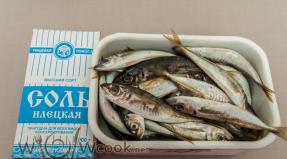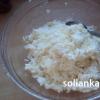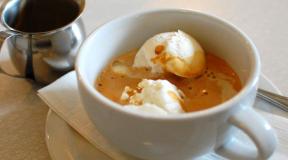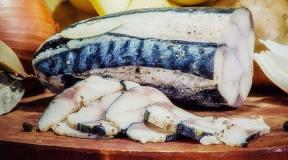Most Interesting Street Food in Germany - Traveler's Cheat Sheet. Food in the city
What did we know about German cuisine before? The same as everyone else. The national German dish is beer with stewed cabbage and sausages. When you think about it, strudel comes to mind. And, undoubtedly, pork. We were partly right. But after all, Germany is not full of strudel! We were surprised to discover how rich, varied, tasty and satisfying German cuisine is. I don’t think I’ll be very wrong if I say that German cuisine is very close to the Russian table.
Interestingly, the famous stewed cabbage with sausages is not served everywhere and not always. In many of the restaurants we visited, this dish was not on the menu. From this we concluded that there are no obvious gastronomic preferences in Germany, like pizza and pasta in Italy, goulash in Hungary or schnitzel in Austria. Dishes vary from region to region. German culinary traditions date back to Roman times. It seems that pork became the main dish even then. You can imagine that a modern German eats almost a centner of pork, or rather - 84 kg of meat per year! At first glance, this is an impressive figure. But if you carry out simple mathematical calculations, it turns out that the average German eats about 7 kg of meat per month, or about 230 g per day. Not so much! Undoubtedly, these kilograms are included in countless different types of sausages and sausages. Experts have calculated that the country produces about one and a half thousand types of different sausages! The Germans love pork roasted over an open fire. We were convinced of the great taste of this dish at and where we were during the Christmas week. The taste and smell of juicy meat shms completely overshadowed visual interest and we did not take a single photo of this divine dish.
We made up for the deficiency a couple of years later. In the village of Brauneberg), pork is cooked a little differently. Over an open fire, but not on a wire rack, but in a huge frying pan. 
And it tasted slightly different from, but it was also extremely tasty! 
This dish was garnished with fresh cabbage and several types of salads and sauces. 
It was difficult for those who were hungry to leave the wine festival in Brauneberg. Who can resist the large chunks of steaming pork roasted on a skewer?

If you think that potato pancakes (potato pancakes) are a national dish or the Czech Republic, where they are called bramborachki, then you have never seen how they are prepared in Germany. Here, the potato pancakes are deep-fried.

We cannot judge their taste and compare them with bramborachki, the delicious cuts of pork have not left a single free inch in our stomachs.
Let's not talk about the interpenetration of gastronomic cultures. Perhaps potato pancakes are a Czech borrowing. Or vice versa? But the goulash definitely arrived in Germany from Hungary. We enjoyed it in Quedlinburg in a restaurant on the main square of the city. I can't compare German goulash with Hungarian, I haven't tried the latter. But German meat soup won my heart immediately and forever.

By the way, on our first visit to Germany, we were surprised to find a hodgepodge! We liked her there very much! We saw that this Russian dish is on the menu of the restaurant c.
 Solyanka is number one!
Solyanka is number one! We also tried it in Quedlinburg. I ate goulash, but the Head of the Expedition ate a hodgepodge, such that not all of our restaurants serve!
 Solyanka on the left, goulash on the right
Solyanka on the left, goulash on the right Vegetables are also well represented in German cuisine. As with us, they are often served boiled for a side dish. We'll come back to cabbage, and besides it, the Germans are happy to eat spinach, carrots, beans and peas. Cucumbers and tomatoes are used raw and made into salads. You can often see onions on the plate, both raw and fried. And, of course, potatoes! In the city, we even dined at a restaurant called "Potatoes", loosely translated "A bag of potatoes." "Restaurant" Potofelsak "in Alsfeld - die, do not get up" - I wrote in. Here the main violin was played by pork to the accompaniment of potatoes.
 Dinner in Alsfeld at the restaurant "Potofelsak"
Dinner in Alsfeld at the restaurant "Potofelsak" In the foreground is pork with potatoes baked with cheese. The second hot head of the Expedition chose three steaks from different types of meat.
For starters, we took a salad with vegetables and fruits. White rings on the bread seem to be pineapples (but definitely not potatoes!). Thin fragrant slices of rye bread are smeared with sauce. Pickled cucumbers spiced up the unusual selection of ingredients.

For such a hearty dinner (one salad, two hot dishes, a lot of beer), we paid 40 euros with a tip. The account pulled at 34.5 euros. (As of early autumn 2014, it cost a little less than 2,000 rubles).
The potato festival continued in Wernigerode. I rebelled against a hearty meat dinner and opted for vegetarian options. Stopped on baked potatoes with raw cheese. She was served with a delicious sauce with mushrooms and an assortment of stewed vegetables.

In the background of the top photo, a light salad of fresh vegetables, mainly cabbage, is included in the frame.
Mushrooms were served with tender pork. Here, it was not without potatoes.

The bill (with beer) again barely exceeded 30 euros.
I'll add a little fly in the ointment to the praises of German cuisine. In some places the food was very average, downright mediocre. In the restaurant of one of the Trace Cardena hotels) we gulped down the dishes served, because we ran off our feet in search of at least some edible establishment, we were tired and very hungry. But even on an empty stomach, the famous German sausages strongly resembled the products of the Mikoyan meat processing plant.
 Dishes at the Trace-Cardin restaurant. I had to stop at the same dishes, the menu was very poor.
Dishes at the Trace-Cardin restaurant. I had to stop at the same dishes, the menu was very poor. We quickly forgot about this failure. In the evening of the next day, we enjoyed real German cuisine in the St. Goara restaurant (Rhine valley). For the second time, we noticed that in Germany it is customary to combine raw and boiled vegetables in salads. We really liked the boiled potato salad with raw vegetables and herbs.

Hungarian goulash has become a permanent feature of German cuisine, and I enjoyed ordering it for dinner. Delicate medallions were brought to the head of the Expedition.

“In Germany you order one dish, but they bring you three plates” - I read in my mine about dinner in St. Goar. This is how it comes out, because the side dish is often served on a separate plate. Not often, but it happened that we were served a plate of salad as a compliment. By the way, this German dinner in St. Goar cost us 25 euros (no tip).
It so happened that St. Goar fed us two evenings. In another restaurant, we felt the influence of French cuisine - I ordered a broccoli puree soup. I remember savoring the most delicate soup with whipped cream.

The Head of the Expedition could hardly cope with his "tart-flambé" - a dish somewhat similar to pizza.

The next day, in a place on the opposite shore from the famous Lorelei mountain, I became convinced that broccoli is a very common dish in Germany. It goes well with salmon melting in your mouth.

Pork, traditional for German cuisine, was poured abundantly with an interesting creamy sauce in this restaurant, which gave the meat a piquant taste.

Once again, the bill for this divine beer lunch was just over the usual € 30. (32.1 euros).
Of all the restaurants shown above, I cannot prefer one over the other. I remember each of them with profuse salivation. But a small, unpretentious cafe in Assmanhausen became special for me. There I tried a German pork leg for the first time. I ate “knee” in the Czech Republic, but this is a different culture, a different way of cooking! In Germany, the pork leg seemed like a dietary dish - not spicy or greasy. But also not fresh, soft, tender, flavored with calm spices. It was accompanied by stewed cabbage and fried potatoes. Only my grandmother could make such potatoes on the stove. I don't even know why I was more delighted - from meat or from a side dish!

The head of the Expedition did not philosophize and ordered a schnitzel. At that time, we were not yet in, and we knew only by hearsay about how it should be. Therefore, and proposed in Asmanhausen, deserved worthy praise.

And the knee? “There are horns and legs left from the pig's goat,” of course!

I'll show you a couple more dishes that we didn't really like. In a restaurant in Heidelberg, the pasta pumped up.

There were no complaints about the meat, but we were sitting outside and on a cool autumn evening, all the food instantly cooled down. And the sausages were not up to par.

Now compare the top dish with the bottom dish.

Are they similar? Yes, yes, in both cases we ordered the top of German cuisine - our favorite, adorable, traditional German fried white sausages with stewed cabbage. But comparing two dishes prepared in different Heidelberg cuisines is like comparing a homemade cutlet with a "beef cutlet." from the Soviet canteen. For rent - a divine dish is prepared in the Vetter beer hall on Steingasse 9 in Heidelberg.
 The “Vetter” beer house at Steingasse 9. In the distance you can see the Alte Brucke bridge.
The “Vetter” beer house at Steingasse 9. In the distance you can see the Alte Brucke bridge. Sweets? And this cannot be taken away from the Germans! The only trouble is that both the Bortjournalist and the Head of the Pastry Expedition are breathing pretty evenly. Rather, the pieces of cakes were the reason for tasting the first in our life.
 Still life in a cafe on the Ruedesheim waterfront
Still life in a cafe on the Ruedesheim waterfront German eateries (Fast food in Germany)
The Germans love to eat. If there is no time and money is in trouble, it is not a big problem to find a quick snack, especially in tourist places. In the city, we could not choose something from the variety of offered ready-made meals. Pay attention to the top left corner of the display case - this open diner also cooks a pork leg!

After much deliberation, two pieces of differently cooked meat moved to our tray. White side dish - potato salad.

Note that the right cut of meat is heavily flavored with fried onions. Not everyone loves it, but we treat the golden onion with due respect. This tray cost us 14.3 euros.
But we had such a homeless snack for ourselves in the town of Braubach ().

It is gratifying that the local supermarket has a department that sells fresh pastries and brews coffee. We bought cold cuts in the same store. And right at the entrance to the supermarket there is a plastic table with the same chairs, so it was very convenient to have a snack.
There are also stalls in Germany that sell real German pretzels. If you see, don't pass by!
 The pretzels on the left showcase one German roll of 60 cents.
The pretzels on the left showcase one German roll of 60 cents. Pretzels bear little resemblance to Russian rolls or bagels. The unpretentious delicacies of our childhood were baked from sweet dough. What a pity that they have sunk into oblivion! Salt is added to the pretzels, so they are slightly salty and very tasty! We went to the tent three times, finished the cooled, but very tasty pretzels in the hotel room and then regretted not having bought more.
In conclusion, I sign my autograph in the form of an impudent, cunning, contented pug, eating a sandwich on both cheeks of Nemezia - a bun with fried sausage. Bursting behind the ears! It was in Wernigerode.

Hungry yet? Then I invite you to!
Far away? Then welcome to
or !
Fast food (English fast food - fast food) - a dish prepared for a quick meal. The format law assumes that the time between preparation and sale should not exceed ten minutes. This is just one of the possible definitions of fast food, but there is still no single definition. At the same time, almost everyone agrees that this is fast food, produced on a large scale, when dishes are not prepared to order, but from semi-finished products.
Today, the fast food industry is one of the fastest growing segments of the economy in the world. Fast food restaurants are found in almost every country in the world: from America to Japan, from Australia to Iceland. McDonald's alone has spread its networks in 119 countries, while local varieties of fast food are innumerable. In Russia, in addition to world "stars", there are also their own: "Rostik" s "," Russian bistro "," Kroshka-kartoshka " , "Teremok - Russian pancakes", as well as countless tents with shawarma and grilled chicken.
Fast food is believed to be a child of the 20th century. In fact, it has existed for centuries, because even the ancient Romans loved to have a quick snack. Often, the "descendants of Mars" refused to cook at home, in many Roman houses there were no kitchens at all. But in every city there was a mass of eateries and bazaars, where they sold all kinds of food. By the way, it was then that the prototype of pizza appeared - a cake made from yeast dough, greased with olive oil. The Romans also had their own hamburgers. They fried beef cakes and ate them with bread.
1. Mint tea, Morocco

Glasses filled to the brim with mint and generous amounts of sugar stand ready to brew the famous Moroccan mint tea. The drink is refreshing on a hot day in Marrakech, but it is more than just a thirst quencher. Tea making and drinking is an integral part of Moroccan culture and a must-see experience that every tourist must go through.
2. Miaokou Night Market in Taiwan

There is an old temple in the middle of the Miaokou Night Market, but the main thing here is the post. Yellow lanterns in the market illuminate tables of traditional Taiwanese salivating treats. Here you will find spicy noodle soup, oyster omelet, snail, glutinous rice and tripe. Taiwan residents and tourists alike agree that a visit to the market cannot be complete without the ice-cold prune bubble dessert fruit.
3. Shanghai dumplings, China

A Shanghai street vendor serves up dumplings, a freshly prepared Chinese favorite in the city. These treats are widely distributed throughout Shanghai and are available to customers in a wide variety of flavors and combinations.
4. Noodles, Thailand

A noodle sieve over an open fire is the main chef in Bangkok's Chinatown. Many passers-by simply cannot resist the skill of these street chefs and the scent of their creations.
5. Chicken entrails, Philippines

Filipino street vendors created this dish, which features chicken entrails on skewers. The giblets are first marinated and then grilled or simply deep fried. This yummy is usually served with sweet, sour or hot sauce.
6. Beach Delights, India

When vacationers on the Goa beach need a break, such goodies always come in handy. At Anyuna Beach, there is always an endless stream of samosas, chicken, soft drinks and other Indian favorites.
7. Grasshoppers, China

Chinese street vendors love this bouquet of skewered grasshoppers, which are always surprising to Western tourists. However, eating insects is not uncommon these days. The Food and Agriculture Organization of the United Nations claims that about 1,400 species of protein-rich insects are regularly consumed by people around the world.
8. Bang Mi Sandwiches, Vietnam

A Vietnamese street vendor serves up this relic of the colonial past with a smile. Banh mi sandwiches are made with a French baguette filled with a delicious variety of meats and vegetables. They are eaten with pleasure throughout Vietnam, especially for breakfast.
9. Sausages, Germany

Only the best types of sausages are served on these trays. Street food lovers in Germany (especially at various festivals and fairs) enjoy Bratwurst, Bockwurst and other sausage delicacies, washed down with delicious German beer.
10. Ceviche, Peru

A chef prepares ceviche in the seaside town of Mancora, Peru. Ceviche is a popular dish throughout Latin America and is made with citrus juice, in this case lime juice, in which a mixture of raw fish and other seafood is marinated.
11. Pork, Cambodia

Tourists do not need to be able to speak Khmer to understand the menu of such a street stall in Phnom Penh. By the way, pork is one of the most common types of meat eaten in the world. In the first place in the consumption of pork in the world is Austria, followed by Spain and Denmark.
12. Rolls Kolkata Kati (India)

Imagine rolls cut from a long "sausage" of eggs, vigorous fresh onions, fresh green chili, delicious slices of meat or fish, baked in the Indian version of the tandoori oven and wrapped in a delicious Indian paratha cake. Popular throughout India (and now in many other parts of the world), this traditional snack is making it harder and harder to compete with other popular fast food items.
13. Cornish Meat Pie (UK)

One of the United Kingdom's most significant contributions to the worldwide history of fast food response. This light "lunch on the go" traditional for the British is baked from dough, which is rolled out in the form of pancakes and which is wrapped around the filling. Filling - beef, rutabagas, carrots, potatoes, onions. By the way, the dish was born in the 18th century among English miners. They say that a specific shape was invented for these pies so that the miners could take them ... with unwashed hands!

A sunny island in the Caribbean is impossible to imagine without the famous beef patties. Numerous restaurants, cafes and street vendors offer this food at every turn, stunning with its juiciness, unique aroma of tropical spices and sauce made from pieces of fish and vegetables, complementing the rich taste of selected minced meat.
15. Cevapcici (Bosnia and Herzegovina)

One of the most popular dishes of the peoples of the Balkan Peninsula. It is fried sausages made from ground meat (beef, pork) with onions and spices. Cevapchichi is served with plenty of sliced onion rings and fresh white bread (pita). Garnish also includes chili peppers, sliced tomatoes or fried potatoes. In the fast food version, sausages are wrapped in thin hot cakes, and sour cream and cheese are used as a sauce.
16. Hotteok Pancakes (Korea)

When your mouth is literally on fire from consumed spicy Asian foods, it is worth remembering that the East is not only spices and hot spices. Imagine, the East is also unique desserts! And if you want the latter and you are also somewhere in Korea, take a look around. You're sure to see the numerous braziers on which these popular soft pancakes stuffed with unrefined sugar, cinnamon, chopped nuts and sesame seeds are prepared right in front of salivating customers.
Top dishes of Ukrainian fast food
1. Hot dog

A hot dog, also known throughout the world as a hot dog, is a dish known to the general public as an American dish, but Germany is not considered its homeland. A certain butcher living in the city of Frankfurt invented thin and long hot sausages called Dachshund, which means dachshund in German. Later, one German emigrant brought these sausages to America and there he opened his own small business, selling sausages wrapped in slices of bread on the streets. The business was very successful and the dish became very popular among Americans. Later, instead of the usual slices of bread, they began to use a hot oblong loaf. This unpretentious sandwich received the name hot dog a little later, when at the beginning of the 20th century, the American artist Dargan created an illustration for such a popular and beloved dish and, not knowing how to correctly translate the name from German, signed the illustration in English. So a hot sausage in a bun became known as a hot dog.

2. Shawarma

As soon as they do not call this oriental dish: shawarma, and shawarma, and even shuarma. Lavash stuffed with minced meat, often chicken, with the addition of various spices, sauces and salad is very popular among Ukrainians. Turkey is considered the homeland of shawarma, and there it is called kebab. Previously, finely chopped fried meat with vegetables and salad was wrapped in a thin Arabian flatbread (pita), later, when the kebab reached Armenia and became known as shaverma, the flatbread was replaced with thin lavash. In this form, this dish reached Ukraine. Of course, the sanitary standards in the shop where shawarma is prepared leave much to be desired. But despite this, many Ukrainians, at their own peril and risk, have tried this dish of Turkish origin at least once in their lives. By the way, if you don't trust street vendors, you can cook shawarma at home.
3. Cheburek

A pie made of unleavened dough and minced meat, called a cheburek, by its origin is a dish of the Crimean Tatar cuisine. Surely, when you came to Crimea, you met more than one cheburek house, where they really sell delicious chebureks. In the modern recipe, not only minced meat, but also cheese, potatoes, mushrooms are used as a filling for cheburek. Here, as they say, the taste and color, the main thing is to remember that the cheburek is fried in hot oil, respectively, this dish is fatty and by no means healthy, as well as high-calorie.
4. Baklava

Baklava, a popular confectionery dish in the east, has long been loved by Ukrainians. It is especially popular on the territory of the Crimean Peninsula - in summer, honey baklava is sold right on the beaches. The first mention of this sweetness dates back to the 15th century, baklava was prepared in 1453 for the Turkish sultan Fatih by his personal chef and so impressed the sultan that he ordered the recipe to be immortalized. Since the port, this multi-layered dessert has been prepared at every celebration. Turkish baklava is considered one of the strongest aphrodisiacs. The honey and nuts that make up baklava contain substances necessary for male strength. Today there are a huge number of types of baklava. At the mere sight of this sweetness, it is difficult to resist and not taste at least a piece.
5. Patty

The classic pie is considered a primordially Russian dish. One of the most famous dishes has come down to us from ancient times. Remember at least Soviet cartoons, for example, the same Little Red Riding Hood, who carried pies for her grandmother. Apparently, even the wolf knew a lot about Russian cuisine, since he kidnapped a girl with pies. Today, pies are still baked for the holidays, especially since there is a huge variety of fillings and shapes. However, if in a restaurant you can still taste a pie according to the most exquisite recipe, then on the counters of "grandmothers" this dish has long turned into street fast food.
6. Cheeseburger McDonalds

In my opinion, in modern society, unfortunately, there are practically no people left who would at least not try at least once a cheeseburger from McDonalds. I myself have a lot of friends who often like to visit the "Mac" - as they call it. Favorite sandwich of millions consisting of buns, meat, cheese, ketchup, onions and pickled cucumber. 
We begin our virtual tour of different countries of the world with the aim of discovering street food that can characterize their country in the best way. These articles are mini-cheat sheets for travelers to help them navigate local food. We will talk about the most popular food, both vegetarian and non-vegetarian. Therefore, vegetarian brothers and sisters, please be understanding. We want our eating habits to be respected, so let's respect other people's food too!
Today we will find out what the Germans and guests who have arrived in this country eat. So, what is she?
What do we know about food in Germany? The fact that the Germans love different sausages, and, of course, beer. And indeed it is. A national feature of street food in Germany is sausages and everything you can cook with them.
1.Döner Kebab or in Russian, doner kebab is the most popular street food in Germany at the present time. People who buy German kebab appreciate it for its taste, satiety, variety of fillings, and, of course, for the speed of preparation. Currently, more than sixteen thousand outlets that prepare doner kebabs are actively trading in Germany. Imagine, every day the Germans (and not only) eat from 200 to 300 tons of such doners. This is a kind of our shawarma, and in our homeland there are also millions of fans of this dish :))) Here, by the way,
By the way, the doner is prepared according to the taste of the client, who chooses the ingredients for himself. There is also a vegetarian dener on sale. It is he who is presented in the photo.

2. Bratwurst. Bratwurst is also a popular fast food product in Germany. It is a pork or beef sausage. Most often, this sausage is served with bread. It turns out that the Bratwurst has over 40 varieties that are common throughout Germany, but the greater variety is found in Northern Bavaria.

Europe has always attracted me personally by the fact that you can get there from almost any Russian city in just a couple of hours by plane, there are a lot of daily flights, and the cost of these flights is low due to their short duration, in addition, various promotions are often offered to these directions. The visa issue today is also resolved quickly enough and without any problems - Europe is interested in tourists! Therefore, if you have always dreamed of walking the streets of German towns, breathing in history and, of course, tasting the most interesting and delicious street food in Germany, then a weekend trip to this country is an option that is available to everyone! Start planning your trip right now - see what prices are offered by airlines now:
3. Sauerkraut translated into Russian - sauerkraut. Sauerkraut is a national dish in Germany. She goes with all dishes - both meat and vegetable. No serious meal is complete without this dish. It would seem that there is something surprising in sauerkraut ?! The fact is that it is eaten not only fresh, but also fried, stewed and even boiled! Therefore, on the streets of German cities, you can easily taste this simple, but at the same time unusual dish.

4.Currywurst or currywurst in Russian. Another very popular type of street food in Germany. What is this dish? It is mainly steamed and then fried pork sausage. It is served with a sauce based on tomato paste with the addition of the well-known spice curry, perhaps this is where the name of the dish comes from ?! The sausage is laid out on a paper plate and is most often served with French fries and chopped onions.

5. Bresel or pretzel in Russian. What else is Germany famous for? These are their bakeries. Even in other countries of the world, you can find a German bakery, where there is always a variety of delicious pastries. German bakeries are always held in high esteem by tourists and not only.
In Germany itself, there is a huge number of bakery shops, in the country there are more than 600 types of bread and 1200 types of various baked goods. One has only to think about these numbers! Therefore, street food in Germany is not only sausages, but also bread products. , so we vegetarians won't stay hungry :)))
Let's go back to the brezel. What is he like? The dough is rolled into a knot and baked. Looks like our pretzel. It is sold both ordinary and with a wide variety of toppings. This form is very popular in German culture, and the symbolism of brezel can be found in a wide variety of places.

6. Bienenstich. Bee Sting Cake. Who said that the Germans only eat sausages with cabbage? Desserts are also very popular in Germany; here they are prepared according to the canons of the classic European forge. For example, there is a popular dessert in Germany. This is a pie-cake made up of several layers. The bottom sponge cake is made from yeast dough, the second is a thick creamy layer, the third is a thin layer, which is a crispy crust of almonds, honey and caramel. This cake is the pride of Germany, going far back in its history. And everyone who comes here is highly recommended to try it! Therefore, street food in Germany is also excellently represented by desserts.

If you nevertheless decide to go to Germany or another European country for a weekend or a longer period, then you will definitely need a hotel, so I suggest you use the hotel search from "Hotellook" - this is a service that will collect hotels suitable for you from all existing hotel directories such as Booking, Agoda and others. Very convenient - everything in one place !!
7. But what about beverages - you ask? And this has its own peculiarities. Of course, the most popular drink of the Germans is beer ... You know this without me. But, for example, you took a piece of pie and ... decided to buy tea to him, as is customary in Russia. But it may turn out that you have to work hard to find tea on sale. Yes, the Germans are not very fond of tea. They give more preference to coffee ... Moreover, they can even offer to your dessert cider. It is a low alcohol drink made from apples. The Germans love him very much and are proud of him, since they consider him their national drink. Well, we are also not bastard, so let's go have a drink of pure water :))) By the way, we can make natural apple cider vinegar from apples. You can see our own recipe for making it at home.

Let's summarize
Street food in Germany is very diverse, there is a place here for desserts and pastries, and even fresh salads. Anyone can find a snack on the streets of Germany - both a classic food lover and a vegetarian. Therefore, forward towards adventure!
In every country on the street you can find completely unusual and interesting dishes for a quick bite. They can be quite exotic, but they will perfectly introduce you to the peculiarities of the country's national cuisine.

Stekt Strömming - Sweden. This is fried herring with vegetables and bread.

Jian Bing Guo Zi - China. This is a thin pancake smeared with an egg.

Kaassoufflé - processed cheese, usually gouda, in fried dough (Netherlands)

South Korean pian-se. Have you watched the cartoon "Kung Fu Panda"? Perhaps you remember those delicious white pies with cabbage and meat filling? This is nothing more than pyang-se, a traditional South Korean fast food. Today it begins to gradually spread throughout the world. And not surprising, because the taste is really amazing.

Cevapcici in Bosnia and Herzegovina. To some, cevapcici may resemble shawarma. However, it may seem like this only for the first 10 seconds. Indeed, there is a tortilla, sauce, small sausages and just a huge amount of onions, but this fast food is different from everything else that is in the world.
Surprisingly, it is street “fast” food that can reveal to the tourist much more cultural peculiarities of the people than expensive dishes in elite restaurants.

Chicken Giblets in the Philippines Sure, the look of chicken innards on skewers isn't exactly appetizing, but their taste can really impress! The offal is marinated for a long time, then fried over an open fire, and then served with sweet and sour sauce. No McDonald's hamburger delivery beats exotic Filipino street food.

Shanghai dumplings: Do you think dumplings are an exclusively Russian dish? But no. In Shanghai, they are sold by street vendors, offering a wide variety of combinations of ingredients and flavors. Surprisingly, this delicacy has managed to fall in love not only with local residents, but also with tourists. If you are in Shanghai, be sure to try it!

German sausages: Lovers of all meat can rejoice when they get to Germany. It is here that sausages are the main fast food. They are presented in a huge variety: pork, chicken, turkey ... An ideal combination with good German beer!

Nicaragua.Nacatamal ("nakatamal") - thick corn mass with various fillings: pork, chicken, rice, potatoes, tomatoes, onions, olives. The filling looks more like minced meat, and this yummy is baked in a banana leaf.

Brazil. Acarajé. Acaraje is a dish made from peeled cow peas. Round buns are first fried in palm oil, and then they are cut and filled with the filling: fried shrimp, cashews, lettuce, green and red tomatoes, hot pepper sauce, beans, ginger, garlic and other ingredients.

Currywurst - Germany. Fried sausage with curry, ketchup, fries or bun. Famous for their passion for Formula 1 racing, Germans love to feast on this dish by purchasing Formula 1 tickets in anticipation of the start of the competition.

Pho soup. It is very difficult to stay hungry in Vietnam, because among the large number of cafes and eateries, everyone can choose food to their liking.

Pique macho is a traditional Bolivian dish. A large plate of food consists of chunks of beef, sausage (usually sausage), fried potatoes, onions, boiled egg, pepper, mustard, mayonnaise, and ketchup. Piqué macho is a very large portion (the smaller one is simply called pique) and, traditionally, spicy due to the addition of spices. According to legend, only a macho can eat a large portion on his own (pique macho in Spanish means to hurt the vanity of a macho).

Mexico - Tostados - If you like crunchy tortillas, tostados is the perfect meal. Tortillas are fried or baked before cooking. Once they are cooled and solid, they can be topped with a whole range of ingredients.

Chaat - India. Toasted bread with many different ingredients, yoghurt and many spices.

Kolbice - Hungarian sausages in a fresh bread dough cone with fried onions, sauerkraut, cheese, mustard and ketchup (Hungary).

Fish and Chips - fish and chips in English. Fish and Chips - a dish of fish fried in batter and cut into large slices of French fries or chips.

Turkey. An excellent option for lunch is balyk ekmek - fish in a bun. On the street grill, vendors fry fresh fish fillets, put them in a bun, add onions and salad. From above, you sprinkle lemon juice on the sandwich that is on the counter, sit on a stool and enjoy! Instead of fish, sometimes there is kyufte - cutlets.

Arepas, Colombia - These round corn cakes are a ubiquitous food in Colombia, even though the country has many different delicacies. Arepas are much thicker than tortillas and are usually fried or baked before being sprinkled with cheese. Especially it is a popular breakfast in Bogota.

Chicken Jerk, Jamaica - A real Jamaican dish, everyone eats it here. The chicken recipe is a closely guarded secret, but the chicken bone dish begins with marinade, allspice, thyme, ginger and green onions. The meat is left overnight so that it is soaked in all the spices, and then fried.

Chili Crab, Singapore The most essential Singaporean dish, chili crab can be found in numerous street food hotspots throughout the country. The recipe for this dish was created by Cher Yam Tian, who began serving spicy crustaceans from a street cart in the 1950s. In this recipe, crabs are fried whole in sweet and sour tomato sauce, an egg, and of course, chili.

Gimpab, South Korea This dish has gained wide popularity in many countries around the world. So this is the so-called Korean sushi. The rolls are twisted with different fillings: crabs, eggs, beef, carrots, then I put this on a roll of rice and algae leaf. In South Korea, this traditional dish can be found all over the place at stalls.

Falafel, Egypt - You will find falafel all over the Middle East. In Egypt, falafel is made from richer beans and is known as ta'amiya. It is almost always sold in pita bread with pickled vegetables, salad and tahini sauce.

Ceviche, Peru - Seviche is considered the national dish of Peru and is also growing in popularity around the world. The marine component is very fresh raw fish that is marinated in lime juice, salt and chili.

Dumplings, Poland - Dumplings, or pierogi, can be found throughout Eastern Europe, but Krakow hosts a festival dedicated to dumplings. They are made from a simple dough: flour, eggs, water and salt, and the filling can be different: meat, cheese, cabbage, potatoes. They boil them first and then fry them a little in oil!

Gelato, Italy - There is nothing like eating balls of creamy gelato and strolling through the evening in Rome. Italians take their ice cream seriously and gelato is different in that it is less greasy and slightly softer; classic flavors include pistachio and stracciatella (creamy ice cream with chocolate chips).

Bunny in Bread, South Africa - This South African snack is a favorite of the locals. The dish consists of a quarter or half of gutted bread filled with a curry rabbit. As you might imagine, this dish is originally from India, but now it is the most famous street food in Durban, where the rabbit can be replaced with chicken, or lamb.

Suya - Nigeria, West Africa. Grilled spicy meat served on skewers with onions, peppers and herbs.

Bacalaitos - Dominican Republic. Fried salted cod.

Kwek-Kwek - Philippines. Deep-fried breaded eggs.

Gaufre de Bruxelles - Belgium. Waffles with cream.

Okonomiyaki - Japan. Fried flatbread with various additives and a special sauce, sprinkled with dried tuna.
During almost 3 months of living in Germany, we ate mainly at home, and accordingly bought food in grocery stores. Food at home comes out on average 300-400 euros for 2 per month.
Eating at home. Where to buy groceries?
Kaufland is a chain that is a little more expensive than the others, but the richness of the range and quality, as it seemed to us, is of the highest class.
Real is a well-known international chain, prices are about the same as in Kaufland, there is also a huge assortment and excellent quality. In my opinion, I even saw Real in St. Petersburg.
Rewe is, as it seemed to me, the most popular network in Germany.

There are as many as 2 large stores in our area. Prices are slightly lower than in Kaufland and Real. As it seemed to us, the assortment is slightly smaller, but the quality is high.
The main feature of Rewe is Ja!

The price of these products has been reduced due to modest packaging (just a white background, and blue letters Ja!), While the quality of these products also does not differ from branded ones.
Kaiser is probably the most expensive store. We bought there only once. I didn’t like it, firstly because of the prices, and secondly because of the small assortment. Perhaps we ended up in a not very successful chain store.
Netto - The main feature of the Netto network DISCOUNTS! And as they say about themselves - the best, freshest and most varied products at a low cost.
Lidl - Just like Netto offers good quality at a lower cost.
Aldi is an international network. Known for the lowest prices.
BIO is another story! There are specialty stores called BIO, and bio products are sold in Rewe, Kaufland, Real, Kaiser.

Bio is just crazy here. Bio products are more expensive, as a rule on such products there are special marks that it is Bio. There are Bio meat, Bio vegetables, fruits, Bio dairy products, Bio dried fruits, Bio cereals, Bio canned food, Bio semi-finished products, Bio vegetable oil, etc.
It is believed that bio products are healthier, without GMOs and all kinds of chemicals. It turns out our chevy little apples, which my grandmother sells in the village and there is BIO, our cereals and unrefined oil for the Germans are also BIO and costs 2 or even 3 times more :).
Food in the city.
It is not possible to stay hungry in the city. Fast food for all tastes is everywhere.
With 2-5 euros in your pocket, you can find what to eat everywhere. Moreover, if we compare the prices for a snack in St. Petersburg, Moscow and, say, Berlin, on average Moscow, St. Petersburg 5-10 euros per person, Berlin 3-5 euros per person.
Dunner - Turkish bistros, Dunner is the name of a Turkish dish, although the Turks themselves say that they do not have such a dish. It looks like this is an invention of the local Turks. Dunner does not look like shawarma, only from real meat or chicken. Dunner's tents, cafes, bistros are almost at every turn.

Dunner and durum dunner are distinguished. Dunner is wrapped in a quarter of a thick pita, and durum dunner is wrapped in thin pita bread.
Ingredients: beef or chicken meat, vegetables, sauce of your choice - garlic, spicy, with herbs. Once I took it with hot sauce. After the first bite, I no longer felt the taste of dunner at all :), the sauce was so spicy.
The cost is from 1.5 euros to 2.5-3, depending on the location of the tent.
Asia snack - thai food... In terms of popularity among the local population, perhaps in the first place. Young people can be seen everywhere with boxes of Thai fried noodles with vegetables or chicken. Asia snack can be found in the form of a cafe, bistro, tent.

In addition to the noodles in the box, a varied menu is offered: traditional soups, the second is rice, fried noodles with beef, chicken, vegetables, etc.

Very tasty and satisfying. Perhaps this type of fast food has become my favorite :).
Serving cost:
To go (a box of fried noodles with vegetables) - from 2 to 2.5 euros - a large portion!
Dishes from the menu - from 2 to 7 euros per serving.
I will say right away, the portions are so large, I have never been able to finish eating until the end.

Sandwiches are various bakeries. It's typically German. There are just a lot of bakeries here. You can find bakeries everywhere too. In every grocery store, in every shopping mall, in the form of separate shops, at train stations.

In the morning, when people go to work in a train carriage every second with a sandwich, they are either already chewing or taking them to work, apparently with coffee at the work table it tastes better :).
In Germany, they love bread with different grains, seeds, and different flours. In bakeries, they make sandwiches from small buns for every taste:

with various sausages: boiled, servilad, smoked, cutlets, boiled pork, etc.
with fish and seafood: herring, sprats, salmon, shrimps
cheeses: regular cheeses, brie, dor blue, etc.
vegetables: lettuce, tomatoes, cucumbers
also sandwiches can include: chopped boiled eggs, butter, mayonnaise, etc.
Sandwich cost from 1.5-3.5 euros.
Fried sausages - German traditional. Germany is the meatiest country in Europe. Meat is their pride and staple food.

Currywurst- red fried diced diced curry, usually with French fries included,
Bratwurst- white fried sausage,
Rostbratwurst- fried red sausage
You can also find it almost everywhere in public places: on mobile tents, cafes, shops. No holiday is complete without fried sausages. This is sacred
The cost of a sausage with a bun from 1.5-3 euros.
The evening can be spent in a cafe, restaurant.
As a rule, they start working at 6 pm.
Biergarten, Kneipe
For beer lovers, a variety of German pubs. Absolutely charming, colorful establishments. During the warmer months, visitors tend to sit outside. Wooden tables and benches.
From food either traditional german dishes:
Haxe or Eisbein (knuckle) with Bratkartoffeln (fried potatoes) and Sauerkraut (sauerkraut)

or ala American burgers.
Dinner cost per person from 5 to 10 euros (depending on the dish),
of them for beer will be about 2 to 3 euros.
The portions are usually gigantic. Sometimes they even took one portion for two.
Thematic restaurants
I will say right away that mainly middle-aged and elderly people go to restaurants here. An interesting observation. The more expensive a cafe or restaurant is, the whiter the heads of the visitors :).
The choice, of course, is also huge here. Traditional German, Thai, Indian, Mexican, Chinese, etc.

Lunch at such a restaurant will cost about 15-30 euros per person.



















